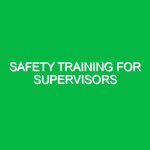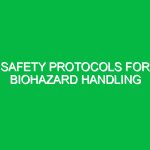In any workplace, the identification of hazards is the cornerstone of creating a safe and healthy environment. Best practices for hazard identification not only help mitigate risks but also ensure compliance with regulations and standards that govern health, safety, and environmental practices. Understanding how to effectively identify hazards can mean the difference between a safe work environment and one fraught with danger. This article delves into essential practices for hazard identification, the potential hazards that may arise, and actionable steps to safeguard against these risks.
Defining Best Practices for Hazard Identification
Best practices for hazard identification refer to the systematic approach used to recognize, assess, and control risks that could lead to injury, illness, or environmental harm. This process involves not just identifying existing hazards but also anticipating potential hazards that could emerge under various conditions. Effective hazard identification is vital for promoting a culture of safety within an organization, encouraging proactive engagement from employees, and ensuring that safety measures are consistently applied.
The Importance of Hazard Identification in HSE
In the HSE domain, hazard identification serves several critical purposes:
- Risk Management: Identifying hazards is the first step in risk management, allowing organizations to control or eliminate risks before they lead to incidents.
- Regulatory Compliance: Most industries are governed by regulations that require regular hazard assessments. Non-compliance can result in fines and legal repercussions.
- Enhanced Safety Culture: A robust hazard identification process fosters a safety-first mindset among employees, promoting awareness and responsibility.
By establishing best practices in hazard identification, organizations can effectively minimize risks and cultivate a safer work environment for all employees.
Identifying Potential Hazards and Risks
Hazards can be categorized into various types, each with its associated risks. Understanding these categories can help organizations tailor their hazard identification processes. Here are some common types of hazards:
1. Physical Hazards
Physical hazards include environmental factors that can cause harm. Examples include:
- Slips, Trips, and Falls: Uneven surfaces, wet floors, and cluttered walkways can lead to serious injuries.
- Noise: Excessive noise levels can lead to hearing loss and increased stress levels.
- Ergonomic Issues: Poor workstation design can cause musculoskeletal disorders.
To identify these hazards, organizations can conduct regular workplace inspections and engage employees in hazard reporting.
2. Chemical Hazards
Chemical hazards arise from exposure to harmful substances. Common examples include:
- Toxic Chemicals: Exposure to substances like asbestos or lead can lead to severe health complications.
- Flammable Materials: Chemicals that can ignite pose significant fire risks.
- Corrosives: Substances that can damage skin or materials upon contact.
Employers should maintain a comprehensive inventory of all chemicals used in the workplace and ensure that Material Safety Data Sheets (MSDS) are readily accessible.
3. Biological Hazards
Biological hazards involve exposure to living organisms that can cause health issues. Examples include:
- Bacteria and Viruses: Pathogens that can cause illnesses like flu or food poisoning.
- Mold: Can lead to respiratory issues and allergic reactions.
- Insects: Pests that can transmit diseases.
Regular health screenings and maintaining hygiene can help in identifying and mitigating biological hazards.
4. Psychological Hazards
Psychological hazards are less tangible but equally important. These include:
- Workplace Stress: High-pressure environments can lead to mental health issues.
- Harassment: Bullying or discrimination can create a hostile work environment.
To identify these types of hazards, organizations should conduct employee surveys and create open channels for communication.
Best Practices for Hazard Identification
Implementing best practices for hazard identification involves a comprehensive approach that engages all levels of an organization. Here are some key practices to consider:
1. Conduct Regular Risk Assessments
Regularly scheduled risk assessments are crucial for identifying new hazards and evaluating existing controls. This proactive measure allows organizations to stay ahead of potential risks. A systematic approach could include:
- Walkthrough Inspections: Conduct physical inspections of the workplace to identify hazards.
- Employee Feedback: Encourage employees to report safety concerns and near-misses.
- Review Incident Reports: Analyze past incidents to identify patterns and areas for improvement.
2. Engage Employees
Employees are often the most familiar with the hazards present in their work environment. Engaging them in the hazard identification process can lead to valuable insights. Consider establishing safety committees or regular safety meetings where employees can contribute their observations and suggestions.
3. Utilize Technology and Tools
Technology can enhance hazard identification efforts. Tools such as mobile apps for reporting hazards, drones for inspecting hard-to-reach areas, and software for tracking compliance can streamline the process. For example, a construction firm could use drones to monitor job sites for safety violations, allowing for quicker responses to potential hazards.
4. Provide Training and Awareness Programs
Training is essential for equipping employees with the knowledge to identify hazards effectively. Regular safety training sessions should cover topics such as:
- How to spot potential hazards in the workplace.
- Emergency response procedures.
- Proper use of personal protective equipment (PPE).
For instance, a manufacturing company could conduct quarterly training sessions that include hands-on demonstrations of hazard identification techniques.
5. Maintain Documentation and Records
Documenting hazard identification processes and findings is vital for accountability and continuous improvement. Organizations should maintain records of inspections, risk assessments, and employee feedback. This documentation not only tracks progress but also serves as a valuable resource during audits or investigations.
Safety Precautions and Actionable Advice
Once hazards are identified, appropriate safety precautions must be implemented. Here are some actionable strategies:
1. Implement Control Measures
Control measures can be categorized into the following types:
- Elimination: Remove the hazard entirely, if possible.
- Substitution: Replace a hazardous substance with a less dangerous one.
- Engineering Controls: Use physical barriers or ventilation systems to minimize exposure.
- Administrative Controls: Change work procedures to reduce exposure.
- Personal Protective Equipment: Equip employees with appropriate PPE as a last line of defense.
2. Develop Emergency Response Plans
Every workplace should have a clear emergency response plan that outlines procedures in case of an incident. This plan should cover:
- Evacuation routes and procedures.
- Emergency contact information.
- Specific actions to take in response to different types of emergencies.
Regular drills should be conducted to ensure that employees are familiar with the plan.
3. Monitor and Review
Hazard identification is not a one-time task but an ongoing process. Regularly review and update hazard assessments and control measures to reflect changes in the workplace or new regulations. This continuous monitoring can help organizations adapt to evolving risks and maintain a safe environment.
Regulations and Standards Governing Hazard Identification
Various regulations and standards govern best practices for hazard identification. Familiarity with these regulations is essential for compliance and safety. Some key regulations include:
- Occupational Safety and Health Administration (OSHA): OSHA standards require employers to provide a safe workplace and conduct hazard assessments.
- Environmental Protection Agency (EPA): The EPA oversees regulations related to environmental hazards and pollution control.
- International Organization for Standardization (ISO): ISO 45001 provides guidelines for occupational health and safety management systems.
Organizations should stay informed about local regulations as well, as these can vary significantly depending on location and industry.
Conclusion
In summary, best practices for hazard identification are essential for creating a safe and healthy workplace. By engaging employees, conducting regular assessments, utilizing technology, and adhering to regulations, organizations can effectively identify and mitigate risks. Remember, a proactive approach to hazard identification not only protects employees but also enhances overall operational efficiency. Implementing these best practices can foster a culture of safety, ensuring that everyone goes home safe at the end of the day.


